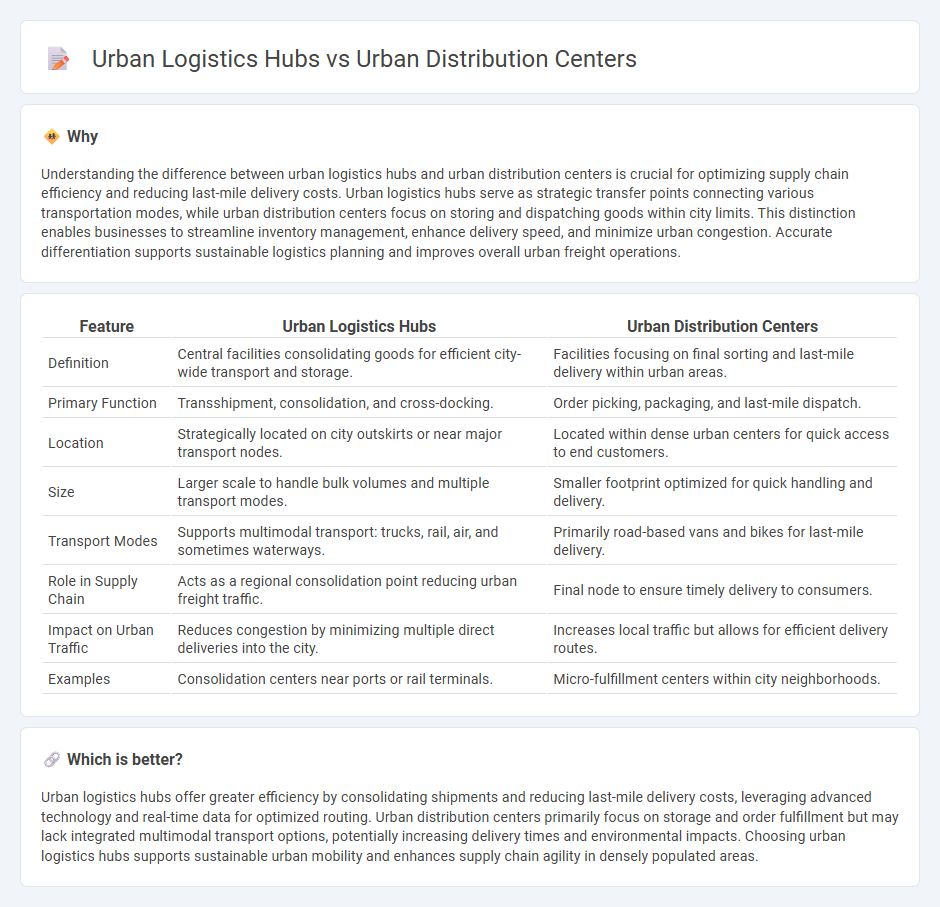
Urban logistics hubs streamline the consolidation and sorting of goods to optimize last-mile delivery efficiency in densely populated areas. Urban distribution centers focus on storage and inventory management closer to end consumers, reducing delivery times and transportation costs. Explore the key differences and benefits of each to enhance your urban supply chain strategy.
Why it is important
Understanding the difference between urban logistics hubs and urban distribution centers is crucial for optimizing supply chain efficiency and reducing last-mile delivery costs. Urban logistics hubs serve as strategic transfer points connecting various transportation modes, while urban distribution centers focus on storing and dispatching goods within city limits. This distinction enables businesses to streamline inventory management, enhance delivery speed, and minimize urban congestion. Accurate differentiation supports sustainable logistics planning and improves overall urban freight operations.
Comparison Table
| Feature | Urban Logistics Hubs | Urban Distribution Centers |
|---|---|---|
| Definition | Central facilities consolidating goods for efficient city-wide transport and storage. | Facilities focusing on final sorting and last-mile delivery within urban areas. |
| Primary Function | Transshipment, consolidation, and cross-docking. | Order picking, packaging, and last-mile dispatch. |
| Location | Strategically located on city outskirts or near major transport nodes. | Located within dense urban centers for quick access to end customers. |
| Size | Larger scale to handle bulk volumes and multiple transport modes. | Smaller footprint optimized for quick handling and delivery. |
| Transport Modes | Supports multimodal transport: trucks, rail, air, and sometimes waterways. | Primarily road-based vans and bikes for last-mile delivery. |
| Role in Supply Chain | Acts as a regional consolidation point reducing urban freight traffic. | Final node to ensure timely delivery to consumers. |
| Impact on Urban Traffic | Reduces congestion by minimizing multiple direct deliveries into the city. | Increases local traffic but allows for efficient delivery routes. |
| Examples | Consolidation centers near ports or rail terminals. | Micro-fulfillment centers within city neighborhoods. |
Which is better?
Urban logistics hubs offer greater efficiency by consolidating shipments and reducing last-mile delivery costs, leveraging advanced technology and real-time data for optimized routing. Urban distribution centers primarily focus on storage and order fulfillment but may lack integrated multimodal transport options, potentially increasing delivery times and environmental impacts. Choosing urban logistics hubs supports sustainable urban mobility and enhances supply chain agility in densely populated areas.
Connection
Urban logistics hubs serve as critical nodes for efficient last-mile delivery by consolidating goods from regional warehouses. These hubs connect seamlessly with urban distribution centers that manage inventory storage and order fulfillment close to consumers. The collaboration between logistics hubs and distribution centers reduces transportation costs, minimizes delivery times, and supports sustainable urban freight management.
Key Terms
Location optimization
Urban distribution centers prioritize proximity to dense consumer markets to reduce last-mile delivery times and transportation costs, leveraging strategic placement near residential and commercial zones. Urban logistics hubs integrate multimodal transport options and technological infrastructure to optimize overall supply chain efficiency, addressing broader urban mobility and congestion challenges. Discover more about how location optimization reshapes urban freight management and sustainability.
Consolidation
Urban distribution centers specialize in consolidating goods from multiple suppliers to streamline last-mile delivery and reduce transportation costs. Urban logistics hubs serve as integrated platforms combining warehousing, transportation, and information services to optimize distribution networks and enhance supply chain efficiency. Explore how these facilities transform urban freight management and improve delivery performance.
Last-mile delivery
Urban distribution centers primarily serve as regional storage and sorting points for goods, streamlining inventory management and bulk shipments before dispatching to local areas. Urban logistics hubs integrate multimodal transport options and advanced technology platforms to optimize last-mile delivery efficiency, reducing congestion and improving delivery speed. Explore the distinctive roles and technological innovations of urban distribution centers and logistics hubs in enhancing last-mile delivery solutions.
Source and External Links
How Urban Distribution Centers Are Revolutionizing Local Food - Urban distribution centers serve as pivotal hubs within city limits that connect small farmers directly with urban consumers, reducing transportation costs, food waste, and environmental impact while ensuring fresh products reach cities quickly.
How Urban Distribution Centers Improve Logistics Efficiency - These centers enhance logistics by cutting delivery times and costs, optimizing last-mile delivery through strategic urban placement, and supporting sustainability efforts through reduced emissions and congestion.
Urban warehouses speed up the last mile - Mecalux.com - Urban warehouses, located close to or within cities, function as warehousing and distribution centers that facilitate rapid same-day deliveries, especially to meet the demands of ecommerce and high-volume small orders.
 dowidth.com
dowidth.com